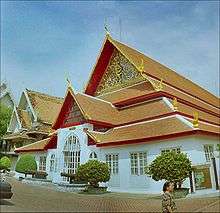Museum of Counterfeit Goods
The Tilleke & Gibbins Museum of Counterfeit Goods is a museum focused on intellectual property infringement in Yan Nawa District, Bangkok, Thailand. It is operated by Tilleke & Gibbins, a law firm with offices in Thailand and Vietnam.[1] In the firm's Bangkok office on the 26th floor of Supalai Grand Tower, the museum is home to a variety of counterfeit and infringed goods that the firm has accumulated in its work.[2]
The museum receives over a thousand visitors each year. Local and international newspapers and magazines such as the Christian Science Monitor and Time magazine have published articles on the Tilleke & Gibbins museum.[3][4]

Purpose
Bangkok has a reputation as one of the world’s premiere marketplaces for counterfeit goods.[5] Consumers sometimes mistakenly view illegal trade in counterfeit products as a "victimless crime".[6][7]
Tilleke & Gibbins founded the museum and raise awareness regarding counterfeiting and other intellectual property issues. The Tilleke & Gibbins Museum of Counterfeit Goods is described as "one of the firm's key corporate social responsibility programs".[8]
The museum shows the issues Thailand faces when tackling forgery, and teaches visitors to spot fake products by showing counterfeit goods alongside their genuine counterparts.[9]
Collection
The museum displays more than 4,000 goods that infringe trademarks, patents, and copyrights. One of the largest of its kind in the world, the museum is home to a collection of 14 broad categories of goods, including clothing, footwear, watches and eyewear, accessories, cosmetics and perfumes, food and household products, drugs, alcohol and cigarettes, copyright works, stationery and office supplies, automotive parts, tools, electrical devices, and miscellaneous products.[10] According to CNN, the museum has "an eye-opening display that shows just how much is counterfeited, how far crooks will go to manufacture fake products, and the very real dangers that the industry creates."[5]
Other unexpected counterfeited goods are shown, such as automotive accessories, bearings, residual-current devices, pencils, glue, and food products.[11]
References
- "Managing Intellectual Property". Retrieved 2013-02-27.
- "Time and Trademark Infringement". Asia Africa Intelligence Wire. Bangkok Post. Retrieved 2013-02-27.
- Krausz, Tibor. "Thailand: Fakery, enshrined". The Christian Science Monitor. The Christian Science Monitor. Retrieved 2013-02-27.
- Jones, Gary (2009-06-08). "Knock It Off: A Thai Museum for Counterfeit Goods". Time World. Time. Retrieved 2013-02-21.
- Jorgensen, Greg. "Faking it at Bangkok's Museum of Counterfeit Goods". CNN Travel. CNN. Retrieved 2013-02-21.
- Bukszpan, Daniel. "Counterfeiting: Many Risks and Many Victims". CNBC. Retrieved 2013-02-27.
- "What are the Economic and Social Consequences of Counterfeiting and Piracy?". World Intellectual Property Organization. Archived from the original on 2013-03-08. Retrieved 2013-02-27.
- "Community Service". Tilleke & Gibbins. Tilleke & Gibbins. Retrieved 2013-02-27.
- "Museum of Counterfeit Goods in Bangkok: Fighting Fakes in Bangkok". Bangkok Magazine. Bangkok Magazine. Retrieved 2013-02-21.
- "Museum of Counterfeit Goods". Tilleke & Gibbins. Tilleke & Gibbins. Retrieved 2013-02-21.
- Christensen, Stefan. "Kopiornas Baksida". Destination Asien. Destination Asien. Archived from the original on 2013-08-26. Retrieved 2013-02-21.
